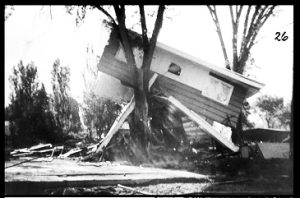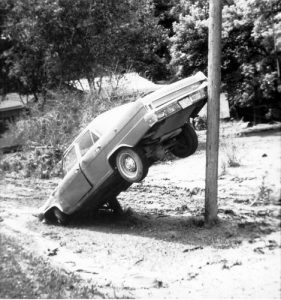Flood of ‘72
 RAPID CITY— On the morning of June 9, 1972, the people of Rapid City awoke to an azure blue sky, a picture perfect Spring morning, birds were singing, children were playing, the sweet scent of Black Hills ponderosa pine drifted right down into the heart of downtown Rapid City. It was a great day to be alive, and if you were a teenager, hanging out in North Rapid with your friends, the day had endless possibilities for fun.
RAPID CITY— On the morning of June 9, 1972, the people of Rapid City awoke to an azure blue sky, a picture perfect Spring morning, birds were singing, children were playing, the sweet scent of Black Hills ponderosa pine drifted right down into the heart of downtown Rapid City. It was a great day to be alive, and if you were a teenager, hanging out in North Rapid with your friends, the day had endless possibilities for fun.
By nine A.M. the idyllic spring morning started to turn strange, in a way which 20/20 hindsight now screams for those who lived through that time to deem portentous. Something just wasn’t quite right. A breed Lakota teenager cut his hand mowing the lawn, had to go to the Sioux San and get nine stitches to close the gash. His friend felt guilty for having caused the hand injury, so he had his injured friend spend the night, and other friends dropped by, and they all stayed up late playing board games. None of them had any inkling of what was to come.
Outside, the weather had changed—a dark, ominous bank of angry rain clouds rolled down off the Black Hills over Rapid City, turning broad daylight into dusk. The top of the clouds towered beyond the range of the human eye to calculate, and the humidity skyrocketed to levels that would have shamed even Chamberlain.
The injured breed Lakota boy’s older brother was driving his girlfriend home, east from Baken Park, in his slapped-together Ford Falcon, when the earthen dam at Canyon Lake, about a half mile to the west of him, torn asunder, in a roar of earth and water West Rapid has never heard before or since. Canyon Lake Park was obliterated, and the neighborhoods to the northeast, following the loop of Rapid Creek, were swept away by a twelve foot wall of raging water. People, the very people who had remarked about the idyllic spring morning just hours before, began dying by the score.
The National Guard knew what was coming. Guardsmen went through those neighborhoods, imploring people to evacuate. But just a decade before, a similar flood warning had gone out, and an old timer said that the Guardsmen had told him then he had to leave, but the water never came up over the top step of his front stoop. Maybe he thought that would happen on this night, but what happened was the water struck with such force the entire house was torn from the moorings behind that front stoop, and shattered into kindling by every object of note as it was swept east, through the Gap, and the shards of what remained left strewn over the neighborhood just north of Omaha Street.
That neighborhood, once the home of the new Boys Club building, just dedicated seven years before, and the Mother Butler Center, where generations of Lakota had turned to for assistance and guidance and community fellowship, and home to thousands of working class Wasicu and urban Lakota, was swept from existence in less than an hour. Dozens more lost their lives.
The older brother’s Ford Falcon was not known for its fine tuned performance. It ran just well enough so the older brother didn’t have to walk, but on that night, it performed to a critical degree of responsiveness. Staying just ahead of the thunderous roar of the oncoming wall of debris bristling water, it was able to escape north, up onto the heights of North Rapid just beyond East North Street.
The wall of water continued on, slamming into the Trisco Feeds grain elevator, an eight story high signature landmark just on the north side of Omaha Street, and redirecting two blocks south; rushing down across the display lots of two car dealerships, and not playing itself out until it had smashed its way several miles down into Rapid Valley, claiming even more lives, and leaving the heart of the largest city in Western South Dakota gutted in its wake.
Rain had fallen in the previous week, saturating the ground, but even had this not happened, the June 9, 1972, rain clouds locked in place and emptied a deluge never before seen during recorded history—over fifteen inches of rain fell in six hours, nearly the entire equivalent of what Rapid City would normally get in a year. Rain fell so hard, wind shield wipers at their highest setting could not keep the windshield from remaining opaque. 
When the deluge had spent itself, 238 people had died in the Black Hills, and 3,057 were injured, many critically so. Some bodies were never recovered, buried deep in mud that filled the exposed basements of shattered homes, lost forever in a torrent of water that left automobiles dangling from the bows of cottonwood trees eight feet off the ground. Almost 1,400 homes were destroyed, and an estimated 5,000 automobiles. The value of the damaged property was estimated at over $760 million in 2017 adjusted dollars.
Rapid City’s 29-year-old mayor, Don Barnett, a local boy made good, was basically handed a flood damaged Excalibur and forced to be a hero. However well he handled the initial devastation of the flood recovery, his real contribution came in the three years to follow. Working hand-in-hand with a 10-member progressive-minded City Council, Barnett was able to initialize many of the city projects and landmarks that came about after the flood, projects many of us probably take for granted. Not only was the Rushmore Plaza Civic Center approved, the bicycle path and flood plain park system which replaced the flood ravaged neighborhoods was approved. The Dahl Fine Art Center was approved, and construction began on the new Central High School.
Attempts were made to name the park after Crazy Horse, since he was born on the banks of Rapid Creek sometime in the 1850’s, but despite the Lakota who had lost their lives and had their neighborhood destroyed, the city was tone deaf to their sensibilities and significance. Even the subsequent mayor, Art LaCroix, who was of Lakota descent, did not support the Lakota call to name the park after Crazy Horse. The tendency of the city to steal Sioux San land for their civic projects and churches, and ignore the Lakota role in the city’s history and development, did not change with the flood, although the Lakota in general received good community treatment in the wake of the disaster.
St. Isaac Jogues, a fixture in the Lakota North Rapid community for decades, and the adjoined Mother Butler Recreation Center, were both destroyed in the flood, Father Francis Collins losing his life in the destruction. The Church and the center were relocated about a mile northeast, on high ground far from the flood plain.
On the morning of June 10, 1972, at the crack of dawn, the Lakota boy who had injured his hand, stood with his friends on East North Street, looking down across the flood plain, across a neighborhood that had once been one third of North Rapid. Nothing remained, nothing but a swath of unimaginable destruction. Despite the declaring of martial law, despite warnings to stay out of the area of devastation, the boys walked down into the devastation. One boy found the foundation of his late Auntie’s log cabin home, but there was no log cabin sitting on it, just a concrete-walled box filled with filthy, debris-cluttered flood water.
Experts talking on the radio said that this type of flood could only occur once every hundred years, but exactly seven days later, another wall of rain clouds rolled down over the Black Hills, and dumped even more rain than had fallen the week before. A couple dozen more people died. The results would have been even more devastating, had the Canyon Lake earthen dam not already emptied its contents.
People, whose homes had not flooded on June 9, had to flee as flood waters rose four feet high inside their living rooms. Response for these victims was hampered by what had happened the previous week, and they were housed in the old Rapid City Auditorium, sleeping in row after row of narrow cots, shivering from typhoid shots, and standing in long lines to use the bathroom or get something to eat.
Almost a half century later, people born and raised in Rapid City after June 9, 1972, can only imagine what the town looked like before the flood, never saw an entire neighborhood that ran a mile long and a half mile wide before it was wiped from the face of the earth.
The memories of Canyon Lake before the flood, the long, narrow docks, far out into the lake, lined with fisherman, fishing by lantern all through the night, soon will be lost forever. But if you drive up to Dinosaur Park, and look down over the horseshoe shaped city, the ghost of that lost Rapid City beckons. Telltale landmarks trigger memories and realities of a smaller, simpler Rapid City, when there was no mall, no civic center, just two shopping centers, one pizza restaurant, three downtown movie theaters, the Rapid, the State and the Elks, and three drive-ins, the Sioux, Starlite and Pines, and between Rapid City and Ellsworth Air Force Base, there was one truck stop and a few implement stores, and nothing else.
There was a lot wrong with that old Rapid City, but reminiscing about the June, 1972 flood reminds us of the tens of thousands of people who lived and died in that Rapid City, reminds us to be grateful for the ever growing and improving city we have now, because the dark turn of nature can change everything in one single, stifling, humid Spring afternoon.
(James Giago Davies is an enrolled member of the Oglala Lakota Tribe. He can be reached at skindiesel@msn.com)
